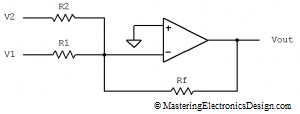The inverting summing amplifier does exactly what its name says: adds the input signals and inverts the result. This amplifier presents a major advantage versus the non-inverting summing amplifier. The input signals are added with their own gain. The disadvantage is the inversion of the sum, which might not be desirable in some cases.
Figure 1
Figure 1 shows the non-inverting summing amplifier with two inputs. Its transfer function is shown in equation (1).
| (1) |
As you can see, this is a simple function. Each signal is added with its own gain created by the feedback resistor, Rf, and the corresponding resistor for that signal. But, why is that? Why is this transfer function a lot simpler than the non-inverting summing amplifier? How can we derive this function? What is the transfer function of the inverting summing amplifier with 3, 4, or n inputs? This article answers all these questions.





